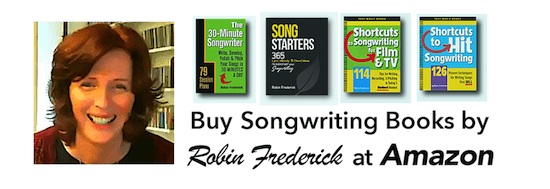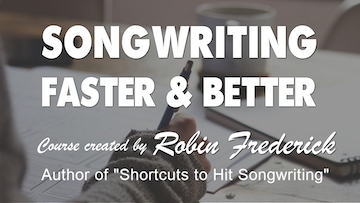Wouldn’t it be nice if you could write songs faster, start new songs that you always finish, and still express yourself in the way you want to? You’d have more songs to pitch, you could reach more listeners, and songwriting would be more exciting and fun to do. You bet it would.
We all want to be more creative, have more songs in our catalog, and feel satisfied that we’re getting things accomplished. It’s just that reality doesn’t always work out that way. More often than not, we run into problems.
- We don’t have any good ideas for new songs.
- We’re not sure what kinds of songs we should be writing and for what market.
- We get stuck working on one song that’s in trouble.
- We’re scared our songs aren’t good enough so we don’t finish them.
We all know that the quality has to be there, but I bet you could write more songs and keep the quality at the level you want or even improve it. Here’s a whole bunch of ideas for writing FASTER and BETTER.

Study successful songs in the genre or market you want to aim for
This is the quickest way to solve a lot of the problems I just listed. Spend at least one to two hours per week listening to a specific songwriting style you want to write in or studying a market like film & TV songs.
Of course, you won’t like everything you hear. You may have to dig a while until you uncover a gem that you love or a song you want to learn from. But it’s worth it and it’s an essential part of the job of songwriting.
Too often we think of our songwriting career as ONLY the act of songwriting, but there’s so much more. Laying the groundwork for new songs, learning how others creatively use song craft, getting inspired, even feeling like you could beat those songs—all of these are ways you can up your game. Get your ears used to hearing what’s successful.
Read Should I Write or Should I Listen?
TRY THIS: Here’s an article in my songwriting blog with a list of resources where you can find successful artists and bands in a range of styles to listen to. Spend one to two hours this week exploring one of the resources in this article. Find at least one song you want to take a closer look at.

Embed current songs to give yourself an instant feel for the style
When you find a song you like, get a copy of the lyrics. (Find them online or take them down by ear). Practice singing along with the track until it’s comfortable for you. This may not be as easy as it sounds. Many recent hit songs have complex melodies and phrasing. If the song isn’t in your range, then talk-sing along with it until you get a feel for the rhythm of the melody. These days, the rhythm of the melody is just as important as the note pitches.
Look up the chords online or take them down by ear and learn to play the song. Sing along as you play to get a feel for how the melody and lyric lines fit into the chords.
READ THIS: Find out more about learning to play chords.
The more familiar you are with contemporary chord progressions, lyrics, and melodies, the faster your songs will come together, the quicker you’ll break out of old habits, and the less time you’ll spend wrestling with elements that sound dated or don’t fit into a genre. You want to aim your song in the direction you choose as early as possible. Embedding the sound of today’s songs physically and mentally will help you target the sound and style you want in your first draft and then keep it on track.

Practice writing in a genre while you start new songs
You can practice a songwriting style just like you would practice guitar, or piano, or voice. And while you’re doing that, you can be racking up ideas for new songs. Here’s how…
> Check out the song structure. Listen to a couple of successful songs in the genre you want to write in and note down the structure of verse, chorus, and bridge. Think about using that structure in your next song.
> Notice the chord progression. Write it out. Is it simple or complicated? What kinds of chords are used in each section? Play the chord progression. Try changing the order of the chords, varying the chords, substituting similar chords. Just don’t stray too far from the overall chord style. No Jazz chords in a Country song, okay? When you find a progression you like, record it. Note where the verses and choruses begin. Keep it to start a song next time you’re writing.
> What’s the lyric style? What kind of language does this genre use? Does it have a lot of imagery or is it mostly direct statements. What kind of characters are featured? Try giving your singer a character like one of these.
TRY IT: Choose one of the ideas in this section, find a successful song you like, and work up a chord progression or lyric idea.


Use templates
Here’s a great way to get a head start on your next batch of songs. A template is an outline, something to provide you with a place to begin and a structure for moving forward. Of course, every song will be different. It will express things in a different way, have different problems to solve, and reflect your personal vision and taste. But you can create a template to shorten the process. If you already invented the wheel, why do it again, right?
RECORDING TEMPLATES: Make it easy to record your ideas. Be sure you have your favorite vocal mic plugged in and ready to go. If you found a good vocal sound last time you recorded, keep all those EQ settings, reverb, and compressors in place on your vocal track. Same for your guitar or keyboard settings. If you’re using recording software of any kind, keep an empty file that’s all set up the way you like. All you want to do is flip the ON switch, then start singing and have it sound decent.
ARRANGEMENT TEMPLATES: If you’re going to be creating your own arrangements, give yourself some basics to build on. Break down the instrumental arrangements of several songs in your genre. Lay out the song structure on a piece of paper and note where instruments enter, drop out, or change playing style. Make a few “road maps” of these songs. Draw a box for each song section and fill int he instruments that are playing and a note describing the way they’re played.
INSTRUMENT TEMPLATES: Don’t waste time auditioning every single sample in your computer to find that haunted, atmospheric soundscape-y thing you loved a couple months ago. Keep a log of all those sounds and make it easy to scan through. List your favorite pads, string sounds, rhythm loops, etc. Include the location of samples, a short description to remind yourself of how it sounds, and any settings you like to change.
SONG TEMPLATES: If you’re really feeling ambitious, try recording a few different song layouts. Use simple rhythm loops and chords to indicate verses, choruses, and bridge. You can add to or change anything later on.

If a song is in trouble, look for a solution or put it on the back burner
Songwriters spend a lot of time trying to fix things – a chorus lyric that doesn’t have a strong payoff, a melody with high notes that only a dog can hear, or a bridge that takes you so far away from the key you can’t get back again. If you’re banging your head against the wall trying to fix a song with a problem, ask yourself if you’re just spinning your wheels. If you are, consider putting that song aside for awhile. Or look at successful songs in a similar style to see how they solved that problem. Then get back to work!
If you can’t find a solution, stop trying. Put the song away and come back to it in two weeks. Listen to the song with fresh ears to see if you really do have a problem after all. If you do, then go through steps 1 and 2 again.
Whatever you do, don’t drive yourself crazy trying to come up with answers out of thin air. Your creativity can only do so much with what it has. Keep adding new knowledge, stimulating it with new techniques, and exploring new territory. The answers are there; you’ll find them if you look.
TRY IT: Choose a generic four-chord progression. You’ll find a few on my blog under Chord Progressions. Or use a karaoke track.
Rough out a verse/chorus lyric and melody. Include a pre-chorus if you like. Do it in 30 minutes or less. Don’t worry about rhyming or being clever, or polishing this thing till it shines. Just say something you want to say.
Record your idea. Come back and listen to it the next day. Make notes on what you want to add or change and do that. Then take another break. Come back the following day, make notes, make changes, walk away.
I’ve got a free course that will show you 10 ways to pick up your songwriting speed and write your best songs!
Copyright Robin Frederick. All rights reserved.

